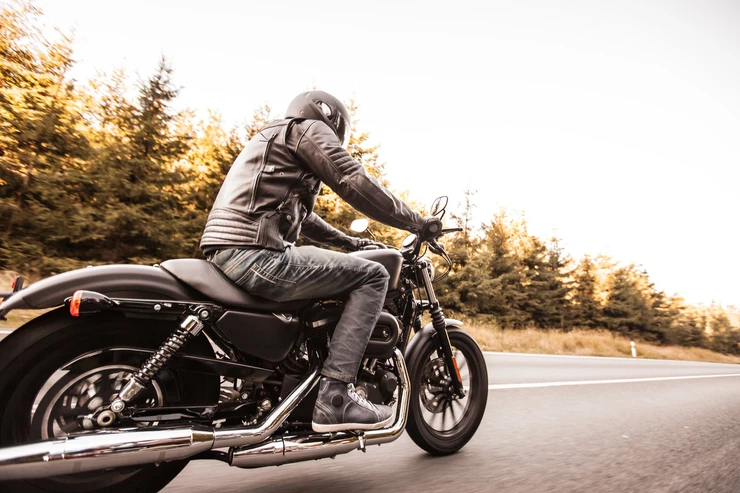Motorcycles are one of the best ways to experience the open road and see part of God’s great countryside; and maybe it’s because of this that Texas can boast that is has more motorcycle owners than any other state. Thankfully Texas understands the joys and freedoms of riding along the open road and has been historically rather reluctant to impose too many stringent regulations upon riders and only passes laws enhancing safety for drivers, passengers, and all others on the road.
Here at Tran Law Group we often field questions from clients who have been involved/ injured in a motorcycle accident; in light of this we wanted to take a minute to provide everyone viewing our little law blog with a nice summary of Texas’ motorcycle laws to further familiarize anyone with an interest with some more nuanced (and particularly applicable to motorcyclists) rules of the Texas roads.
Required Equipment
First, Texas state law requires that motorcycles all have the equipment listed below in proper working order. All items on the list are essential for the proper and safe operation of the motorcycle and to ensure the safety of others sharing the road with motorcyclists.
-
License Plate Lamp
-
Rear Red Reflector
-
Head Lamp (1) (modulating permitted)
-
Vehicle Identification Number
-
Wheel Assembly
-
Exhaust System
-
Tail Lamp (1)
-
Stop Lamp (1)
-
Horn
-
Mirror
-
Steering
-
Brakes
-
Tires
Make sure that all equipment is in good working order between regular inspections. If some items malfunction, such as tail lamps, you can be liable for a fine.
Earning Your Class M License
In Texas, drivers cannot apply for a Class M motorcycle license until they have completed and passed a motorcycle operator training course approved by the Texas Department of Public Safety.
The basic course covers a wide range of topics pertaining to motorcycle safety, including
-
Tips on the safe riding of a motorcycle
-
What clothing will protect you while riding
-
Avoiding obstacles and other highway hazards
-
How to get out of difficult or life-threatening traffic situations
Besides the basic course, Texas offers an intermediate level, one-day course for those with some experience, but who want to learn more about safety on the roads.
To receive a license, the driver must pass a written test on motorcycle operation. A road test may also be required, but can be waived for adults with experience. Minors between 15 and 17 must pass the road test, no exceptions.
The road test assesses the driver’s skill in controlling the motorcycle, staying in the proper lane, correct use of turn signals, and ability to observe traffic and predict problems
Does Texas Have a Motorcycle Helmet Law?
While Texas does have a law requiring some to wear a helmet, most can and do escape that mandate by meeting a small set of very modest requirements.
A) you must be at least 21 years old
B) you must carry proof that you have at least $10,000 in medical insurance
C) you must also have passed an approved motorcycle safety course.
While the law permits helmetless riding, experts strongly urge that motorcycle drivers and riders wear helmets.
For those mandated to wear helmets, Texas requires that the headgear meet Federal Motor Vehicle Safety Standard #218. Furthermore, experts say that helmets should fit the head snugly, but comfortably and also be properly secured. Remember that cracks or dents can impair the ability of the helmet to protect the head and helmets equipped with proper protection can prevent eye damage, some sunburn, and hearing loss.
Texas law forbids law enforcement from pulling over motorcycles solely to determine if the driver carries proper insurance or has taken the Department of Public Safety approved motorcycle safety course.
Laws Pertaining to Passengers
Motorcyclists cannot carry passengers in Texas unless the vehicle is designed to carry more than one individual. The motorcycle also must have approved footrests and handholds designed to accommodate a passenger.
Laws Pertaining to Parking
Texas does have specific laws and regulations pertaining to parking a motorcycle. Failure to adhere to these could result in fines.
Most of these laws simply pertain to parking a motorcycle in an area marked for disabled drivers or passengers.
Texas motorcycle laws prohibit the parking of such vehicles in disabled labeled spaces unless it carries a disabled license plate or a special state-issued removable windshield identification marker.
No driver can use the marker unless transporting an officially approved disabled individual. Also, one cannot lend the marker to another even if that person has a disability themselves.
Many municipalities have also outlawed standing in a disabled parking area even if the driver does not leave the vehicle.
Exhaust and Muffler Laws
Though most states have laws that govern the function of a motorcycle muffler and also regulate the decibel levels produced, Texas actually does not have any on the books. But here is where common courtesy gets involved.
Is Lane Splitting Legal In Texas?
Many states have no laws or regulations prohibiting or governing lane splitting. This describes a situation where two separate motorcycles drive side by side in the same lane. Drivers from both Texas and other states should remain aware that Texas forbids this type of activity. The Texas Transportation Code mandates that those caught lane splitting may find themselves ticketed and liable for a fine.
Although a recent study out of California indicated that lane splitting produces some benefits, such as reducing congestion and enhancing safety, Texas still forbids the practice and will ticket and fine those engaging in the practice.
What Equipment Is Checked in a Legal Inspection?
All vehicles registered in the state of Texas, from tractor trailers to motorcycles, must pass an annual safety inspection. This ensures that all vehicles meet minimum safety requirements for operation on the road. Regular inspections help to protect both drivers and other vehicles on the road from accidents caused by malfunctioning equipment.
A motorcycle inspection will check the following items to ensure that they meet minimum legal safety requirements under Texas motorcycle laws:
-
Tail Lamp
-
Stop Lamp
-
License Plate Lamp
-
Rear Red Reflector
-
Head Lamp
-
Horn
-
Mirror
-
Steering
-
Brakes (system)
-
Tires
-
Wheel Assembly
-
Exhaust System
-
Motor, Serial, or Vehicle Identification Number.
Once the motorcycle passes state inspection, the owner will receive a certificate to be displayed somewhere near the license plate at the rear of the vehicle.
Texas additionally has a liability insurance requirement that motorcycle owners must carry at least $30,000 to cover the death or bodily injury of one person, $60,000 to cover the death or bodily injury of a second person, and $25,000 to cover any property damage incurred.
Owners must also register their bike with their county assessor’s office for personal property tax purposes at which time they will be granted the state approved license plate to be displayed on the rear of the vehicle at all times. This license plate must also carry a valid and current registration sticker at all times.
Other Important Legal Information
Motorcyclists should remember that most laws that govern the operation of an automobile also regulate those of a motorcycle. Motorcyclists must also obey laws governing safe movement in traffic.
Meaning that police or other Law Enforcement Officers will pull over and ticket those who commit speeding offenses, pass vehicles unsafely or without signaling, or otherwise disobey any rules governing vehicle operation.



